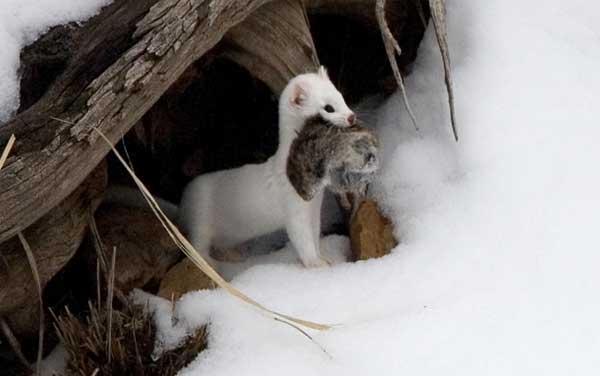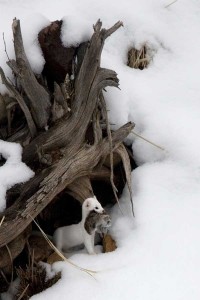
An ermine in Yellowstone National Park captures a vole and surveys the area before making off with his prey. (©Meg Sommers - click to enlarge)
By Meg Sommers
All good things come to those who wait — isn’t that what they say? The same is true with Yellowstone photos, but it also pays to stay connected. An informal photographers’ grapevine helps any shooter know where and when to look for a great shot.
This image of an ermine catching a vole is a combination of having good information about where to look, being patient for the critter to appear, being ready when it does appear and being in the right place at the right time. A little luck and good connections helps too.
Knowing where to look for animals in Yellowstone and Grand Teton national parks may be clear to you because of personal experience or habitat expertise. More often though, it will come to you because someone told you that a particular animal has been seen frequently in a certain location.

Being patient and polite with tourists, rangers and photographers can help build your "photographers' grapevine" for information on opportunities for great Yellowstone photos. (©Meg Sommers - click to enlarge)
The more frequent the reports, the better your chances of seeing it too. I get my “intel” for Yellowstone photos from friends in all sorts of places. Fellow photographers are a really good source. As are rangers, clerks in the stores and yes, sometimes even a first-time Yellowstone visitor who wouldn’t seem know an ermine from a wolverine. Sometimes, a tourist can tell you what they have seen, even if they didn’t know what it was or where.
While being rude to a casual tourist in Yellowstone Park or Grand Teton Park probably won’t have any lasting effects on your photography career. (Though it’s not likely to brighten anyone’s day.) But how you act around Yellowstone and Grand Teton rangers and fellow photographers probably will. Rangers and seasoned photographers have at least one big thing in common: they are there because they love it. If you come often enough to the park, you will begin to recognize both the rangers and many of the other photographers.
The rangers will talk to you no matter what, because it’s their job. And when you are pleasant and polite to them, they may share sightings or other info that will help you get great Yellowstone photos. You can increase your odds of that by being relaxed and respectful, not just with rangers, but everyone. Rangers, by the way, have a really tough job sometimes. They are tasked with both protecting the resource (animals among other things) and helping you to enjoy the view. They have to make choices based upon what they will need for anticipated crowd control and how close the animal is to the crowd and how dangerous they perceive the animal to be. You will notice rangers much more excited about crowd control when there is a sow grizzly with cubs, for instance, compared to an itinerate coyote.
‘Indicator species’ for Yellowstone photos
Your fellow photographers are usually just as excited to see what you see. Some will have larger equipment. Lens envy is a very real thing in the world of Yellowstone photography and every photographer can fall victim to it. In the park, you will often see substantial gatherings of these large lenses. These lenses and the photographers behind them, gather in a line for four reasons. There is something worth waiting for, the correct distance has been established and the best angle has been collectively determined. Also, most of these people know and like each other. They are also something I like to call an “indicator species.” Just like watching elk behavior to anticipate whether or not a predator is in the vicinity, a collection of large lenses definitely indicates there is something worth stopping to see.
Even though you might find their equipment intimidating, the photographers should not be. If you are respectful and polite, they will readily tell the casual tourist what they are waiting for and why. If you show genuine interest in the natural world and not just a “what can I see next attitude,” most Yellowstone photographers will really open up. They will tell you in detail about what they are looking at and other things that might be down the road in the direction you are headed.
Shot with a Canon EOS 5D, ISO 100, F/5.6 at 1/500 second, using a 500 mm lens with 1.4 extender and a tripod.
I got this shot, “Connoisseur,” as a beneficiary of this sort of photographers’ grapevine. This is an ermine — white in winter and brown and beige in the summer. It also is known as a stoat or a short-tailed weasel. This little guy had been in the same spot, over and across the road, in about a quarter-acre area, for over a week. All we had to do, once armed with the information, was go there and wait. Within 15 minutes, there he was. In and out all over the place. They are extremely fast animals, and your only chance is when they stop to survey and take a breath. Here he went into the root ball and by the count of about five he was out with the vole. He took a second to look around, and I took the shot.
So be prepared, but be polite, curious and well-connected too, and when you get your chance, take the shot.
Contact Yellowstone Gate at 307-213-9818 or info@yellowstonegate.com.

Meg is correct, networking it the single best route to exponentially expanding your nature portfolio.
Nice article Meg :D
I still love this shot, Meg. I bet not many people would be able to identify this white beauty as an ermine. You have an enviable talent.
Linda